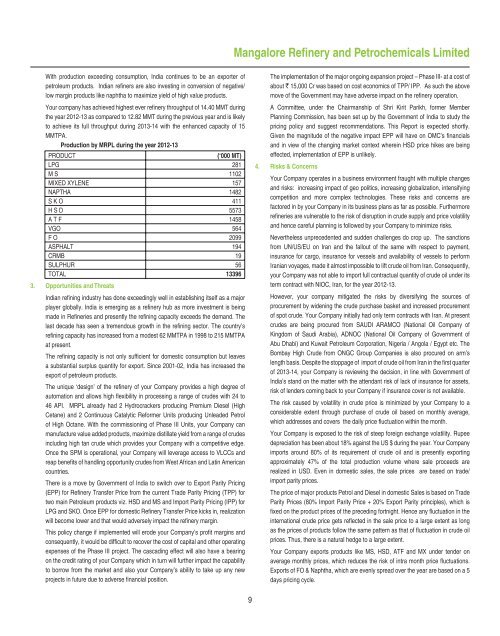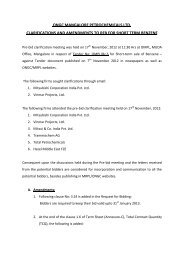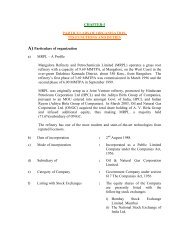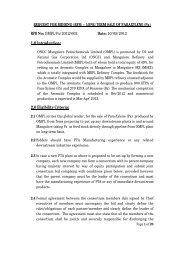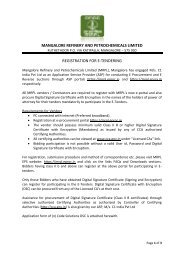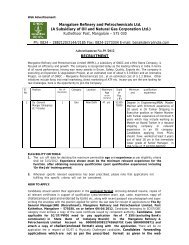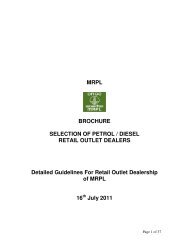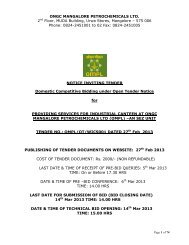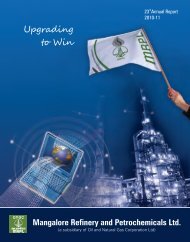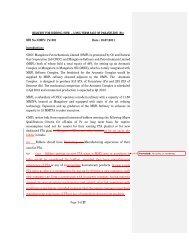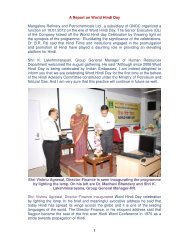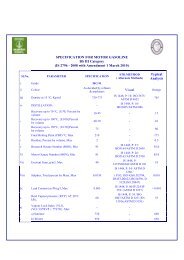Annual Report for 2012-13 - Mangalore Refinery and ...
Annual Report for 2012-13 - Mangalore Refinery and ...
Annual Report for 2012-13 - Mangalore Refinery and ...
You also want an ePaper? Increase the reach of your titles
YUMPU automatically turns print PDFs into web optimized ePapers that Google loves.
<strong>Mangalore</strong> <strong>Refinery</strong> <strong>and</strong> Petrochemicals Limited<br />
With production exceeding consumption, India continues to be an exporter of<br />
petroleum products. Indian refi ners are also investing in conversion of negative/<br />
low margin products like naphtha to maximize yield of high value products.<br />
Your company has achieved highest ever refi nery throughput of 14.40 MMT during<br />
the year <strong>2012</strong>-<strong>13</strong> as compared to 12.82 MMT during the previous year <strong>and</strong> is likely<br />
to achieve its full throughput during 20<strong>13</strong>-14 with the enhanced capacity of 15<br />
MMTPA.<br />
Production by MRPL during the year <strong>2012</strong>-<strong>13</strong><br />
PRODUCT<br />
(Â000 MT)<br />
LPG 281<br />
M S 1102<br />
MIXED XYLENE 157<br />
NAPTHA 1482<br />
S K O 411<br />
H S D 5573<br />
A T F 1458<br />
VGO 564<br />
F O 2099<br />
ASPHALT 194<br />
CRMB 19<br />
SULPHUR 56<br />
TOTAL <strong>13</strong>396<br />
3. Opportunities <strong>and</strong> Threats<br />
Indian refi ning industry has done exceedingly well in establishing itself as a major<br />
player globally. India is emerging as a refi nery hub as more investment is being<br />
made in Refi neries <strong>and</strong> presently the refi ning capacity exceeds the dem<strong>and</strong>. The<br />
last decade has seen a tremendous growth in the refi ning sector. The country’s<br />
refi ning capacity has increased from a modest 62 MMTPA in 1998 to 215 MMTPA<br />
at present.<br />
The refi ning capacity is not only suffi cient <strong>for</strong> domestic consumption but leaves<br />
a substantial surplus quantity <strong>for</strong> export. Since 2001-02, India has increased the<br />
export of petroleum products.<br />
The unique ‘design’ of the refi nery of your Company provides a high degree of<br />
automation <strong>and</strong> allows high fl exibility in processing a range of crudes with 24 to<br />
46 API. MRPL already had 2 Hydrocrackers producing Premium Diesel (High<br />
Cetane) <strong>and</strong> 2 Continuous Catalytic Re<strong>for</strong>mer Units producing Unleaded Petrol<br />
of High Octane. With the commissioning of Phase III Units, your Company can<br />
manufacture value added products, maximize distillate yield from a range of crudes<br />
including high tan crude which provides your Company with a competitive edge.<br />
Once the SPM is operational, your Company will leverage access to VLCCs <strong>and</strong><br />
reap benefi ts of h<strong>and</strong>ling opportunity crudes from West African <strong>and</strong> Latin American<br />
countries.<br />
There is a move by Government of India to switch over to Export Parity Pricing<br />
(EPP) <strong>for</strong> Refi nery Transfer Price from the current Trade Parity Pricing (TPP) <strong>for</strong><br />
two main Petroleum products viz. HSD <strong>and</strong> MS <strong>and</strong> Import Parity Pricing (IPP) <strong>for</strong><br />
LPG <strong>and</strong> SKO. Once EPP <strong>for</strong> domestic Refi nery Transfer Price kicks in, realization<br />
will become lower <strong>and</strong> that would adversely impact the refi nery margin.<br />
This policy change if implemented will erode your Company’s profi t margins <strong>and</strong><br />
consequently, it would be diffi cult to recover the cost of capital <strong>and</strong> other operating<br />
expenses of the Phase III project. The cascading effect will also have a bearing<br />
on the credit rating of your Company which in turn will further impact the capability<br />
to borrow from the market <strong>and</strong> also your Company’s ability to take up any new<br />
projects in future due to adverse fi nancial position.<br />
The implementation of the major ongoing expansion project – Phase III- at a cost of<br />
about ` 15,000 Cr was based on cost economics of TPP/ IPP. As such the above<br />
move of the Government may have adverse impact on the refi nery operation.<br />
A Committee, under the Chairmanship of Shri Kirit Parikh, <strong>for</strong>mer Member<br />
Planning Commission, has been set up by the Government of India to study the<br />
pricing policy <strong>and</strong> suggest recommendations. This <strong>Report</strong> is expected shortly.<br />
Given the magnitude of the negative impact EPP will have on OMC’s fi nancials<br />
<strong>and</strong> in view of the changing market context wherein HSD price hikes are being<br />
effected, implementation of EPP is unlikely.<br />
4. Risks & Concerns<br />
Your Company operates in a business environment fraught with multiple changes<br />
<strong>and</strong> risks: increasing impact of geo politics, increasing globalization, intensifying<br />
competition <strong>and</strong> more complex technologies. These risks <strong>and</strong> concerns are<br />
factored in by your Company in its business plans as far as possible. Furthermore<br />
refi neries are vulnerable to the risk of disruption in crude supply <strong>and</strong> price volatility<br />
<strong>and</strong> hence careful planning is followed by your Company to minimize risks.<br />
Nevertheless unprecedented <strong>and</strong> sudden challenges do crop up. The sanctions<br />
from UN/US/EU on Iran <strong>and</strong> the fallout of the same with respect to payment,<br />
insurance <strong>for</strong> cargo, insurance <strong>for</strong> vessels <strong>and</strong> availability of vessels to per<strong>for</strong>m<br />
Iranian voyages, made it almost impossible to lift crude oil from Iran. Consequently,<br />
your Company was not able to import full contractual quantity of crude oil under its<br />
term contract with NIOC, Iran, <strong>for</strong> the year <strong>2012</strong>-<strong>13</strong>.<br />
However, your company mitigated the risks by diversifying the sources of<br />
procurement by widening the crude purchase basket <strong>and</strong> increased procurement<br />
of spot crude. Your Company initially had only term contracts with Iran. At present<br />
crudes are being procured from SAUDI ARAMCO (National Oil Company of<br />
Kingdom of Saudi Arabia), ADNOC (National Oil Company of Government of<br />
Abu Dhabi) <strong>and</strong> Kuwait Petroleum Corporation, Nigeria / Angola / Egypt etc. The<br />
Bombay High Crude from ONGC Group Companies is also procured on arm’s<br />
length basis. Despite the stoppage of import of crude oil from Iran in the fi rst quarter<br />
of 20<strong>13</strong>-14, your Company is reviewing the decision, in line with Government of<br />
India’s st<strong>and</strong> on the matter with the attendant risk of lack of insurance <strong>for</strong> assets,<br />
risk of lenders coming back to your Company if insurance cover is not available.<br />
The risk caused by volatility in crude price is minimized by your Company to a<br />
considerable extent through purchase of crude oil based on monthly average,<br />
which addresses <strong>and</strong> covers the daily price fl uctuation within the month.<br />
Your Company is exposed to the risk of steep <strong>for</strong>eign exchange volatility. Rupee<br />
depreciation has been about 18% against the US $ during the year. Your Company<br />
imports around 80% of its requirement of crude oil <strong>and</strong> is presently exporting<br />
approximately 47% of the total production volume where sale proceeds are<br />
realized in USD. Even in domestic sales, the sale prices are based on trade/<br />
import parity prices.<br />
The price of major products Petrol <strong>and</strong> Diesel in domestic Sales is based on Trade<br />
Parity Prices (80% Import Parity Price + 20% Export Parity principles), which is<br />
fi xed on the product prices of the preceding <strong>for</strong>tnight. Hence any fl uctuation in the<br />
international crude price gets refl ected in the sale price to a large extent as long<br />
as the prices of products follow the same pattern as that of fl uctuation in crude oil<br />
prices. Thus, there is a natural hedge to a large extent.<br />
Your Company exports products like MS, HSD, ATF <strong>and</strong> MX under tender on<br />
average monthly prices, which reduces the risk of intra month price fl uctuations.<br />
Exports of FO & Naphtha, which are evenly spread over the year are based on a 5<br />
days pricing cycle.<br />
9


